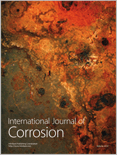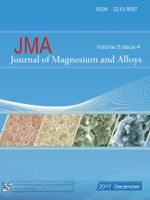
Ochrona Przed Korozja
Scope & Guideline
Championing the Fight Against Corrosion
Introduction
Aims and Scopes
- Corrosion Protection Technologies:
The journal emphasizes the development and application of various corrosion protection technologies, including coatings, surface treatments, and cathodic protection methods. - Materials Science and Engineering:
Research related to the properties and performance of materials in corrosive environments, including studies on coatings, alloys, and composite materials. - Sustainable Practices in Corrosion Management:
Focus on environmentally friendly and sustainable corrosion management practices, including the use of eco-friendly materials and processes. - Industry Applications:
Exploration of corrosion protection in specific industries, such as construction, automotive, and energy, highlighting case studies and practical implementations. - Innovative Research and Development:
Promotion of novel research findings and technologies that enhance the understanding and mitigation of corrosion-related issues.
Trending and Emerging
- Advanced Coating Technologies:
There is an increasing focus on advanced coating technologies, including nanomaterials and eco-friendly formulations, which enhance corrosion resistance while minimizing environmental impact. - Smart Coatings and Self-Healing Materials:
Emerging research on smart coatings and self-healing materials is gaining attention, showcasing innovative solutions that respond to environmental changes and repair themselves. - Corrosion Monitoring and Assessment Techniques:
A trend towards the development of advanced monitoring and assessment techniques, including the use of IoT and big data analytics, to improve corrosion management practices. - Interdisciplinary Approaches:
Research increasingly integrates interdisciplinary approaches, combining materials science, engineering, and environmental science to tackle complex corrosion issues. - Microbiologically Influenced Corrosion (MIC):
An upsurge in studies addressing microbiologically influenced corrosion, highlighting its significance in various industrial applications and the need for targeted protection strategies.
Declining or Waning
- Traditional Coating Methods:
There seems to be a decline in publications focusing on traditional coating methods, as newer, more advanced techniques gain traction in corrosion protection. - General Corrosion Mechanisms:
Research papers discussing general corrosion mechanisms without specific applications or innovative approaches are becoming less frequent, indicating a shift towards more applied research. - Basic Material Properties:
Studies that solely focus on the basic properties of materials under corrosion conditions are waning, with a preference for research that integrates application and technology. - Historical Reviews and Overviews:
While historical perspectives have value, there is a noticeable decrease in papers that provide general overviews of past corrosion practices, as the focus shifts to contemporary issues and solutions.
Similar Journals

International Journal of Applied Ceramic Technology
Driving excellence in applied ceramic research.International Journal of Applied Ceramic Technology, published by WILEY, serves as a key platform for advancing the field of ceramics and composites with a rich focus on innovation and practical applications. With an ISSN of 1546-542X and E-ISSN 1744-7402, this journal has established its presence in multiple disciplines, indicated by its impressive Q3 rankings in Ceramics and Composites, Condensed Matter Physics, Marketing, and Materials Chemistry as of 2023. Covering research from 2004 to 2024, it provides a comprehensive repository of knowledge that aids in the understanding and development of materials. Although it lacks Open Access options, the journal maintains rigorous peer-review standards that ensure high-quality publications for researchers, professionals, and students alike. Given its scopus rankings, including a commendable #61 in Ceramics and Composites, this journal is pivotal for anyone looking to deepen their expertise and engage with the latest advancements in ceramic technology.

International Journal of Corrosion
Unveiling the Secrets of Corrosion for Better MaterialsInternational Journal of Corrosion is a distinguished peer-reviewed journal published by HINDAWI LTD, focusing on the critical field of corrosion research, a vital aspect of materials science and chemical engineering. Since becoming an Open Access journal in 2010, it has provided a platform for disseminating pivotal findings related to corrosion mechanisms, prevention strategies, and innovative materials designed to counteract corrosion, thus directly impacting industries ranging from construction to energy. The journal boasts a respectable impact reflected in its Scopus rankings, holding a Q3 quartile in both Materials Science and Process Chemistry and Technology, with commendable rankings of #157 out of 463 and #37 out of 73, respectively. By fostering knowledge exchange and collaboration among researchers, professionals, and students, the International Journal of Corrosion plays an essential role in advancing the understanding of corrosion phenomena, thereby contributing significantly to the development of more resilient materials and sustainable engineering practices.

CORROSION ENGINEERING SCIENCE AND TECHNOLOGY
Empowering research to mitigate corrosion impacts.CORROSION ENGINEERING SCIENCE AND TECHNOLOGY is a pivotal journal dedicated to the exploration and advancement of corrosion knowledge and technologies, published by SAGE Publications Inc. This esteemed journal holds an ISSN of 1478-422X and an E-ISSN of 1743-2782, and is available for access in the United Kingdom and beyond. With a converged timeline from 2003 to 2024, it continues to publish high-quality research, fostering innovation in the fields of Chemical Engineering, Chemistry, and Materials Science, currently ranked in the Q3 quartile in these categories as of 2023. Additionally, the journal's Scopus rankings—211th in General Chemistry, 145th in General Chemical Engineering, and 266th in General Materials Science—underscore its commitment to disseminating impactful research. As an open-access journal, it invites researchers, professionals, and students to engage with cutting-edge developments in corrosion science, offering insights and solutions critical to numerous industries and enhancing collective academic understanding.

Materials Science-Medziagotyra
Innovating Tomorrow's Materials TodayMaterials Science-Medziagotyra is a prominent peer-reviewed journal dedicated to the field of materials science, published by Kaunas University of Technology in Lithuania. Since its transition to an Open Access model in 2012, it has facilitated broad dissemination of research findings, enhancing accessibility for researchers and professionals worldwide. This journal is indexed in Scopus and has consistently contributed to the academic community with a focus on innovative materials and their applications, ranking in the Q3 category of Materials Science (miscellaneous) as of 2023. With the responsibility of synthesizing substantial research from 2008 through 2024, Materials Science-Medziagotyra aims to bridge gaps in material research while fostering collaboration among scientists, students, and industry leaders. Its commitment to quality and rigor in scientific discourse underscores its relevance and importance in advancing the field.

Journal of Magnesium and Alloys
Connecting Global Minds in Magnesium ResearchThe Journal of Magnesium and Alloys is a prestigious, peer-reviewed academic publication dedicated to advancing the field of materials science, particularly focusing on magnesium and its alloys. Published by KEAI PUBLISHING LTD since 2013, this Open Access journal enables unrestricted dissemination of research findings, enhancing global collaboration among researchers, professionals, and students. With an ISSN of 2213-9567 and a significant impact factor, it has established itself in the upper quartiles (Q1) of both the Mechanics of Materials and Metals and Alloys categories, ranking #3 out of 176 and #9 out of 398 respectively according to Scopus. The journal aims to provide a forum for the latest advances in the understanding, production, and application of magnesium alloys, fostering innovation and sustainable practices within the materials engineering community. Based in Beijing, China, the journal is committed to bridging gaps in current knowledge and driving future research directions through its high-quality publications.

npj Materials Degradation
Enhancing Knowledge in Materials Sciencenpj Materials Degradation is a premier open-access journal published by NATURE PORTFOLIO that has rapidly established itself in the field of materials science since its inception in 2017. With its focus on the degradation processes affecting materials and their applications, this journal is essential for researchers and professionals seeking to advance their understanding of the longevity and sustainability of materials. The journal boasts an impressive impact, classified in the top quartile (Q1) of categories such as Ceramics and Composites, Materials Chemistry, and miscellaneous areas of Chemistry and Materials Science, as evidenced by its Scopus rankings where it ranks #17 in Chemistry (miscellaneous) and #27 in Ceramics and Composites. With open access options allowing for a broader dissemination of research findings, npj Materials Degradation serves as a vital platform for the dissemination of innovative research and interdisciplinary collaboration, enhancing the collective knowledge in the ever-evolving landscape of materials engineering and science.

JOURNAL OF THERMAL SPRAY TECHNOLOGY
Advancing Thermal Spray Innovations for Tomorrow's MaterialsJOURNAL OF THERMAL SPRAY TECHNOLOGY, published by SPRINGER, is a leading platform dedicated to the advancement of thermal spray processes and materials, providing high-quality research pertinent to both industrial applications and scientific inquiry. With an ISSN of 1059-9630 and E-ISSN 1544-1016, this journal holds a distinguished position within the academic community, as evidenced by its Q2 rankings across multiple categories including Condensed Matter Physics, Materials Chemistry, and Surfaces, Coatings and Films. The journal serves as an essential resource for researchers, professionals, and students, offering insights into innovative methodologies, emerging technologies, and critical reviews within the field of thermal spray technology. As it converges from 1992 to 2024, it continues to expand its impact, fostering collaboration and dialogue among experts, and contributing significantly to material science disciplines. With a consistent focus on cutting-edge research and practical applications, this journal remains vital for those invested in the future of materials technology.

International Journal of Corrosion and Scale Inhibition
Unveiling Insights into Corrosion DynamicsInternational Journal of Corrosion and Scale Inhibition (ISSN: 2305-6894, E-ISSN: 2305-6894), published by VSEROSSIISKAYA ASSOTSIATSIYA KORROZIONISTOV, is a distinguished open-access journal dedicated to advancing knowledge in the critical fields of corrosion science and material degradation processes. Established in 2012, this journal serves as a vital platform for researchers, professionals, and students aiming to explore innovative solutions to corrosion-related challenges across diverse industries. Located in the Russian Federation, it boasts commendable rankings, placing it in the Q2 category for both Materials Chemistry and Metals and Alloys, signifying its significant impact within the scientific community. With a robust Scopus ranking—a commendable 40th out of 176 in Materials Science for Metals and Alloys and 120th out of 317 in Materials Chemistry—the journal highlights its pivotal role in disseminating research that shapes the future of material durability and sustainability. By fostering open access to scholarly work, the journal ensures that critical findings are accessible to a broad audience, thereby promoting knowledge sharing and collaboration in the quest to mitigate corrosion and enhance material performance.

Advances in Materials Research-An International Journal
Elevating the Standards of Materials Research WorldwideAdvances in Materials Research - An International Journal is an esteemed publication in the field of materials science, spearheaded by TECHNO-PRESS. Established to provide a critical platform for the dissemination of high-quality research, this journal focuses on a broad spectrum of topics, including Biomaterials, Ceramics, Composites, Electronic, Optical, Magnetic Materials, Metals, Alloys, and Polymers. With a commendable impact factor reflecting its substantial contribution to the scientific community, Advances in Materials Research promotes innovative ideas through rigorous peer-review processes and supports the continuous advancement of materials research, particularly in the dynamic environment of South Korea. This journal, which holds impressive rankings across various subfields in the Scopus database, is designed to cater to the needs of researchers, professionals, and students aiming to stay at the cutting edge of materials science. By bridging gaps between theory and application, it invites contributions that push the boundaries of knowledge and technology in diverse material applications.

RUSSIAN JOURNAL OF ELECTROCHEMISTRY
Exploring the Frontiers of Electrochemical ScienceThe Russian Journal of Electrochemistry, published by Pleiades Publishing Inc, is a reputable scientific resource that caters to the dynamic field of electrochemistry. Since its inception in 1996, this journal has become a platform for the dissemination of cutting-edge research, exploring both foundational studies and innovative applications within electrochemical science. Despite currently holding a Q4 categorization in its field, the journal is dedicated to enhancing its scholarly impact and visibility, reflecting its commitment to fostering advancements in electrochemical technologies. With its ISSN 1023-1935 and E-ISSN 1608-3342, the journal strives to reach a global audience of researchers, professionals, and students alike. Though the journal is not open access, its contents are crucial for anyone looking to stay at the forefront of electrochemical research and developments. The journal's editorial board includes well-respected experts, ensuring that published articles contribute significantly to the scientific community and pave the way for future innovations in the field.